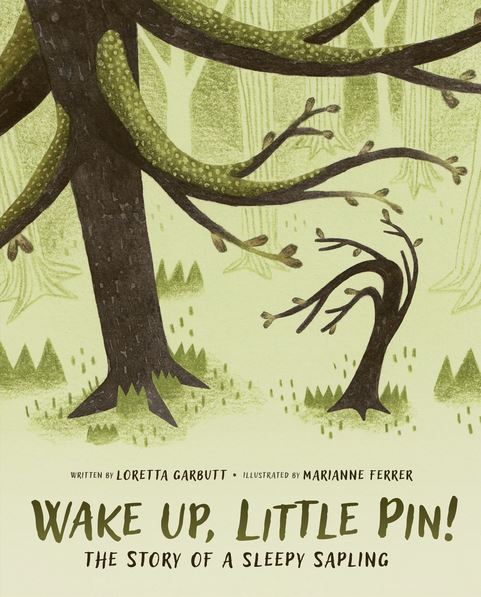Wake Up, Little Pin! The Story of a Sleepy Sapling

Wake Up, Little Pin! The Story of a Sleepy Sapling
Wake Up, Little Pin! is a science lesson on woodland ecology embedded within the story of Little Pin Oak’s genesis on a forest floor, nurtured by his mother tree and the other plants and animals that surround him.
Mother Pin rustled her boughs and whispered gently,
“Time to wake up, Little Pin. Spring is here.”
Little Pin continued to sleep.
“Oh, dear,” said Mother Pin. “This one needs
a bit of help.”
A frisky squirrel, a vole, other trees with branches full of chirping birds gladly share their space with Mother Pin and her sapling. Red Squirrel dashes around as Mother Pin’s messenger, asking Vole to dig extra tunnels to aerate the soil. Beech, birch and elm trees add water “from the tips of their buds” to make the stream run a little faster so that Little Pin can have a refreshing drink. Next Mother Pin calls on the fungi.
The fungi’s cottony webs soaked up the energizing
sugars Mother Pin shared. Then the fungi used their
underground network of threads that reached far and wide,
sending the nourishment traveling towards Little Pin.
With all of this attention, including some enrichment to the soil provided by Porcupine’s dung, Mother Pin is encouraged to see Little Pin coming to life.
That bright morning, Little Pin Oak stretched the tips
of his young limbs wide and reached as high as he could
with the top of his crown. After a long winter’s
sleep, the sun felt good. The young tree was wide awake now.
The last page of the story makes it clear that both Mother Pin Oak and Little Pin are now happy and healthy, firmly established in their forest home.
Three pages of back matter, which include a short bibliography, elaborate on the life of a forest, and will help teachers and parents lead discussions about the book’s subject. The mother, or hub tree, is an important player in forest growth, and, as the author’s note says, “Some scientists believe that the mother trees use their roots to recognize their saplings and care for them, the way Mother Pin looks out for Little Pin.”
The gentle tone of the text is mirrored in the soft greens and browns of the illustrations. Lush foliage and the animated shapes of the living creatures, down to the ants crawling through a tunnel and the nematodes underground, are executed naturalistically in watercolour. I have seen that robin and the chickadee in my back yard and observed squirrels like the one here running along my fence. Yet these creatures, and even Mother Pin and her offspring, seem to express individual personalities. The words and pictures work together to uncover and describe the deepest secrets of forest life.
Wake Up, Little Pin! will not be the liveliest addition to a story time programme, but it should be a great springboard for discussion about the quiet workings of the world around us and an encouragement to watchfulness when out in nature. Owlkids has published another strong addition to the primary nature study shelves.
Ellen Heaney is a retired children’s librarian living in Coquitlam, British Columbia.
